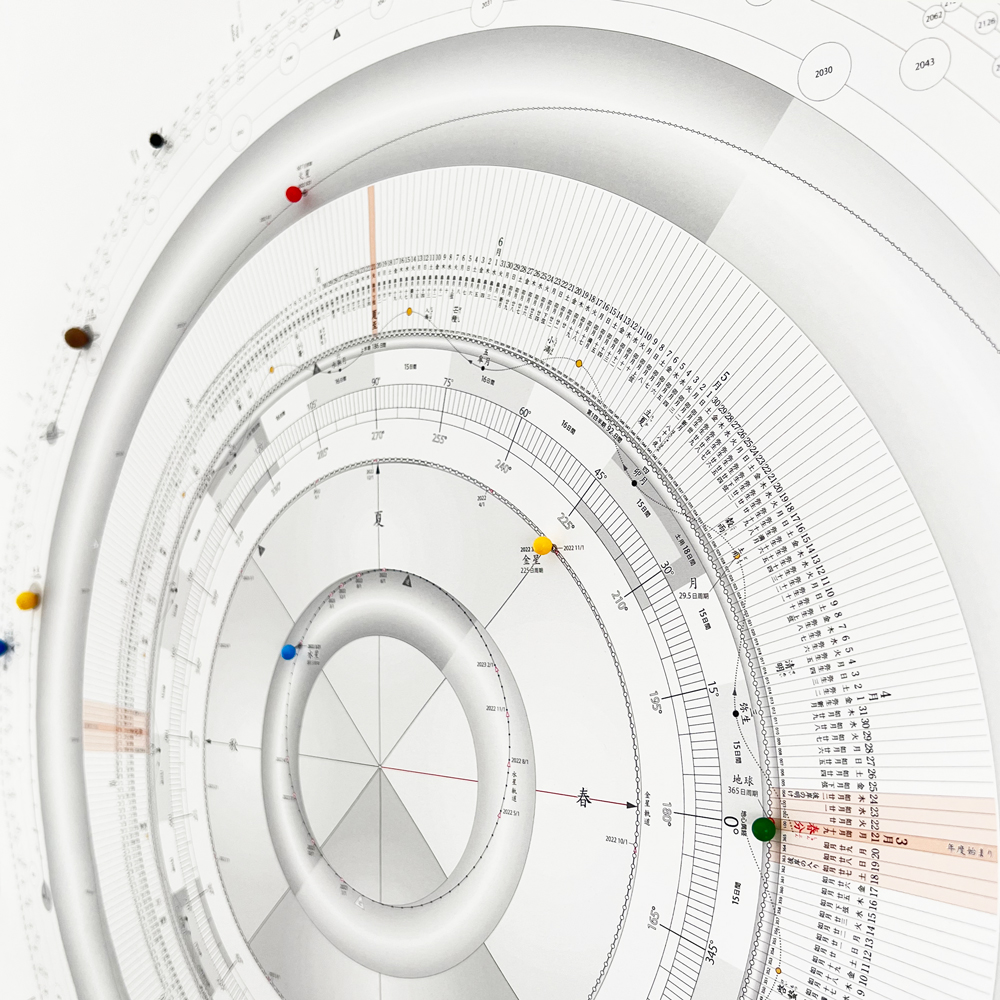#19
decorating
Helio Compass
Heliostera
SURUGA, Shizuoka, Japan
- paper
- W59.4cm H84.1cm
the product:
The HELIO COMPASS is a map of time and space that shows the movements of the planets in our solar system during a year, scaled down to 1:1,000,000,000,000. The calendar, which represents the year as a 360-degree circle, begins the 365-day year with the vernal equinox, when the morning sun rises in the east and the length of day and night are almost equal.The orbits of the planets, “Mercury, Venus, Earth, Mars, Jupiter, Saturn, Uranus, Pluto and Neptune” are marked in a left-handed rotation with the sun at the center, and by setting up the nine large/small “planet pins" (sold separately), you can get a bird's eye view of the movement of the universe around the earth and sun where we are every day.
The daily cycle of the earth's rotation around the sun, the monthly cycle of the moon, and the yearly cycle of the earth's rotation around the sun.
We can feel that we are living in “now” in the magnificent cycle of the universe.
In addition to the time cycle, the following information is included: the orbit of the moon around the earth, the western calendar, the lunar calendar,
Nijushisekki*, Sakugenbo**, Wakusei Kaigo***, and Doyo****.
In addition to using it as a calendar, you can also use it to display as an art poster, or write down anniversaries and plans for the year.
It is used by farmers to record the growth of crops and plants, by athletes to record the metabolic cycle of cells such as bones, muscles and blood, and by pregnant women to record the 40 weeks of pregnancy. By recording your mood, physical condition, menstrual cycle, etc., you may be able to see your own 365-day rhythm that you were not aware of.
* The 24 seasonal divisions:
A name that represents the 24 seasonal milestones of the year, such as the first day of the spring, solstice, and the coldest season.
** Phase of the Moon:
A calendar that shows the lunar cycle in four phases: new moon, first quarter moon, full moon, and last quarter moon.
*** Planetary Alignments:
It indicates when two celestial bodies are in line and the planets are in direct alignment.
**** Canicular Days:
the period of about 18 days of seasonal change right before the first day of spring, summer, autumn and winter.
The contents of A1 unfolded poster case
・Leaflet
・1 worksheet
The photo is the Japan Standard Time version (World Time +9:00).
(...)
(-)
the maker:
After graduating from a music school, Kaichi Sugiyama began making calendars in 2002 while taking over his family's farming business in Shizuoka, after thinking deeply about “time" and “calendars". Essentially, clocks read time that cannot be seen, and in order to live in tune with nature, he believes it is important to use calendars to grasp time as a spatial sense. In this context, Sugiyama went to Mexico and other parts of Central and South America to learn from indigenous people about the relationship between the measurement of time and celestial bodies, inspired by the ancient Mayan calendar, which is different from the algorithm that runs today's society. After returning to Japan, he became interested in calendars used around the world, including the Western calendar, the Islamic calendar, and the Jewish calendar.
Eventually, he realized that there was a need for an easy-to-understand calendar that could be commonly used by all of us on the earth, which explains the fact that the earth rotates around the sun in 365 days and the rotation of the moon. In 2007, he completed the “Helio Compass”, the earth calendar as a compass to show a new sense and direction for us on the Earth in the universe.
Since then, the Helio Compass has continued to be improved year by year to be a simple prototype, stripped down to the bare essentials so that it can be used freely by people with different ideas. In addition to the Japanese Standard Time version (in Japanese), Heliostera also produce American and Korean versions.
The Helio Compass has been adopted by some elementary and junior high schools and is spreading to various fields.
At the Anjo City Cultural Center Planetarium in Aichi Prefecture, an installation that allows visitors to experience the Helio Compass through images and music is on permanent display. Together with a chef Masayuki Okuda, he produced the book “Tabemono Jikan”, a catalogue of Shonai's seasonal climate, which won the Grand Prix in the Heritage category of the 2017 Gourmand World Cookbook Awards. In addition, since 2017, he has been releasing a collaborative CD with the ambient artist Hiroki Okano, which expresses the flow of time in the solar system in a single song every year. The work has been highly acclaimed both in Japan and abroad.
(...)
(-)



